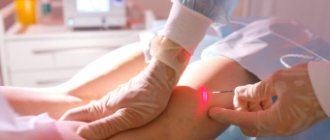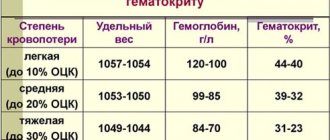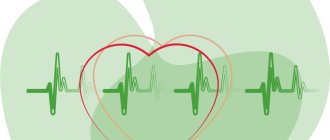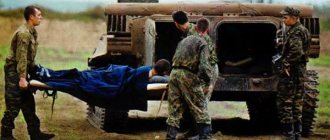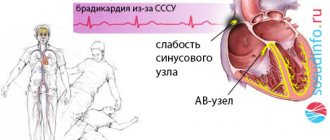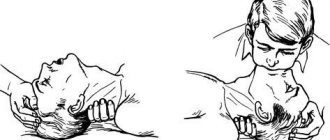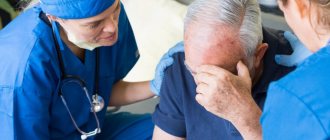What is cardiogenic shock
Cardiogenic shock develops mainly against the background of small-focal or extensive myocardial infarction. As a result, blood circulation throughout the body is sharply disrupted. When this condition develops, it is possible to save the patient’s life only in 10% of cases, despite timely assistance and resuscitation measures.
A dangerous condition occurs due to a sharp disruption of the contractile function of the myocardium. This can be provoked by myocardial infarction, dilated cardiomyopathy, aortic stenosis, damage to the interventricular septum and other diseases. Cardiogenic shock entails a critical decrease in blood pressure. At the same time, activation of the sympathetic nervous system occurs, which provokes excitation of cardiac activity.
A sharp decrease in cardiac output is accompanied by a decrease in the amount of blood in the arteries, this entails fluid retention in the body, the load on the heart muscle increases, and pulmonary edema develops. In turn, the accumulation of under-oxidized metabolic products causes metabolic acidosis.
Symptoms
Symptoms of cardiogenic shock
- rapid breathing;
- dyspnea;
- sudden rapid heartbeat (tachycardia);
- foggy consciousness;
- loss of consciousness or fainting;
- weak pulse;
- pallor and increased moisture of the skin;
- cold hands and feet;
- decrease in the amount of urine excreted (oliguria).
Symptoms of myocardial infarction
Most often, cardiogenic shock develops in people who have suffered an acute myocardial infarction, and therefore it is important to know the signs and symptoms of myocardial infarction.
They include:
- pressing or squeezing pain in the center of the chest that lasts several minutes;
- the pain can radiate to the shoulder, arm, back, or even to the teeth and jaw;
- prolonged pain in the upper abdomen;
- shortness of breath;
- cold sweat;
- feeling of anxiety, depression;
- fainting;
- nausea and vomiting.
Calling your doctor immediately when these signs and symptoms appear can help reduce your chance of developing cardiogenic shock.
How to recognize a dangerous condition
The sooner help is provided for cardiogenic shock, the greater the chance of saving the patient’s life. The clinic always depends on the condition that caused the shock. With myocardial infarction, a person experiences severe pain in the chest, a feeling of fear and panic appears. If the heart rhythm is abnormal, the patient notices a pain syndrome in the chest, the heart sinks or, conversely, the heart rate increases. If the cause of cardiogenic shock is pulmonary embolism, the person suffocates, becomes weak, and sometimes coughs up blood.
Cardiogenic shock causes severe chest pain and other symptoms
Further development of shock is accompanied by the following symptoms:
- the appearance of cold sticky sweat;
- blue lips, nose, fingertips;
- pale skin;
- the patient’s anxiety or lethargy;
- swelling of the neck veins;
- decreased temperature of the extremities;
- feeling of panic and fear.
With pulmonary thromboembolism, the skin on the head, chest and neck becomes earthy or marbled in color.
Important! In the absence of the necessary help, the patient loses consciousness, cardiac and brain activity stops, and death occurs.
Process diagnostics
Since we are talking about an emergency condition, there is no time for long thoughts and verification of the diagnosis. We need to do everything quickly.
Shock is diagnosed based on visual findings and some objective information:
- Heartache. Patients experience severe discomfort, complain, moan, and behave restlessly.
- The skin is pale, cold sticky sweat appears on the forehead.
- Body temperature below 36 degrees Celsius.
- Cyanosis of the nasolabial triangle (blue discoloration of the skin around the lips) is almost always present.
- There is shortness of breath and suffocation. Patients cannot take in air normally and suffocate.
- Tachycardia, bradycardia with an abnormal heartbeat (the pulse either quickens or slows down, there is no rhythm, it beats chaotically).
- Heart sounds (during auscultation) are muffled.
- A late sign of cardiogenic shock is a drop in blood pressure below 90 to 60, or by more than 30 mmHg. Art. below the individual norm.
- Dysuria, signs of renal dysfunction.
- History of cardiac diseases and endocrine pathologies. Most often senile age (60 years or more).
Before conducting a full diagnosis (ECG, ECHO-CG), it is necessary to put the patient in order and stabilize the condition. In the future, already in a hospital setting, you need to look for the root cause of the pathological process.
Pre-hospital emergency care
If signs of cardiogenic shock are detected, it is necessary to call an ambulance as soon as possible and provide emergency assistance to the person. To do this, follow these steps:
- Place the patient on any surface, the body should be in a horizontal position, legs slightly elevated. This position ensures better blood flow to the brain.
- During emergency care, it is important to provide fresh air into the room. To do this, you need to open the window or front door. Crowds should not be allowed near the victim.
- The person's neck and chest must be freed from clothing. If there is a tight collar, tie, scarf or other items, they should be removed.
- At the initial stage, you need to measure the patient's blood pressure. In cardiogenic shock it is always reduced. To normalize the indicators, you need to give the patient a drug that contains dopamine, metazone or hydrocartisone.
- If the person is conscious, taking analgesic medications is allowed.
After this, you should wait for the ambulance, and after the doctors arrive, tell them under what circumstances the shock developed.
First aid for the development of shock should be immediate.
Resuscitation measures
In case of loss of consciousness and respiratory arrest, urgent resuscitation measures must be performed. Artificial respiration is performed mouth to mouth. To do this, the person’s head needs to be tilted back, placing a cushion made of a towel or any other fabric under the neck. The person performing resuscitation must inhale air, cover the victim's nose with his fingers, and exhale air through the victim's mouth. You need to take up to 12 breaths in one minute.
During the provision of first aid, it is necessary to monitor the patient’s pulse. If a person loses consciousness and heartbeats cannot be heard, chest compressions must be performed. To perform it, the patient is placed on his back, the surface must be hard. The person performing the massage should position himself to the side of the patient. The heels of your palms should press down on the chest area in the middle. Pushes are performed with straight arms; there is no need to bend them. The frequency of pressing is at least 60 shocks per minute. If an elderly person is being resuscitated, the number of pushes per minute is up to 50, for children - 120 pushes. Important! When performing artificial respiration and chest compressions simultaneously, you should alternate 2 breaths with 30 shocks.
Helping a patient in a hospital setting
The algorithm of actions of doctors depends on the characteristics of the patient’s condition. The first medical measures are carried out in the ambulance. The following methods are used here:
- the use of oxygen therapy - the procedure helps to support the patient’s breathing and maintain vital functions until arriving at the hospital;
- use of narcotic analgesics. This event helps reduce severe pain. Medicines such as Droperidol, Promedol, Fentanyl and others are used here;
- to eliminate the risk of blood clots in the arteries, a person is given heparin;
- solutions of Dobutamine, Dopamine, Norepinephrine help normalize the heart rate;
- Injecting insulin with glucose helps improve the nutrition of the heart muscle;
- Panangin, Gilurythmal, Lidocaine help eliminate tachyarrhythmia;
- sodium bicarbonate solution is administered to improve the body's metabolic processes.
Further treatment of cardiogenic shock in a clinical setting involves continuation of therapy started at home and in the ambulance. Upon admission of the patient to the hospital, an immediate comprehensive examination of the body is carried out. This helps to identify contraindications and the risk of side effects that may complicate the situation.
In a hospital setting, resuscitation measures are carried out aimed at restoring the patient’s vital functions
The further standard of care depends on the disease that caused the development of shock:
- a condition in which pulmonary edema occurs requires the prescription of Nitroglycerin, the use of alcohol solutions, and diuretics;
- severe pain is relieved with the help of strong narcotic analgesics, which include Morphine, Promedol, Fentanyl;
- Treatment of severely low blood pressure is carried out using Dopamine solution;
- to preserve breathing in an unconscious patient, tracheal intubation is performed;
- Oxygen therapy helps prevent oxygen starvation of the brain and other organs.
If a person’s condition is serious, it is necessary to use a heart-lung machine and artificial ventilation. During this period, the patient should be provided with the necessary nursing care. It consists of performing hygiene procedures, regularly measuring blood pressure, body temperature and feeding the patient.
Forecast
Directly depends on the degree of development of cardiogenic shock. In mild cases, the survival rate is 20%; with proper actions, you can minimize the likelihood of developing heart failure in the future. But relapses are possible, which turn out to be fatal.
- Moderate grade is associated with 50% mortality. It is not easy to relieve this condition; relapse occurs in the first few days.
- A severe form completely deprives the patient of any hope of survival. Mortality is close to 100%. Even if life is preserved, patients die from heart failure in the first few years.
- The most dangerous period is the first 2-3 days.
In Europe, the mortality rate is 50%. In Russia and the CIS countries, due to insufficient qualifications of doctors and technical insecurity - 70-80%. Even successful stabilization of the condition is not a guarantee of further survival.
Emergency surgical treatment
If a patient's condition in cardiogenic shock does not improve after using drug therapy and resuscitation measures, doctors use surgery to help save the person's life. The operation is performed exclusively in a hospital setting using the necessary medical equipment.
To combat the symptoms of cardiogenic shock, the following techniques are used:
- coronary artery bypass grafting – consists of creating an additional bloodstream, which is used as a bridge before the upcoming myocardial transplantation;
- intra-aortic balloon counterpulsation - the technique is carried out by introducing a special balloon, which inflates when the heart muscle contracts. A procedure is performed to normalize blood pressure;
- percutaneous transluminal coronary angioplasty - involves restoring the integrity of blood vessels, which ensures normal contractile function of the heart and maintaining vital body processes at the proper level.
In the absence of timely resuscitation measures, severe consequences of cardiogenic shock develop. These include heart failure, cerebral vein thrombosis, trophic ulcers of the stomach, intestines and other conditions. Even with timely and competent medical care, death occurs in 90% of cases. This is explained by the severe course of cardiogenic shock and its frequent complications. To avoid this condition, it is necessary to direct efforts towards its prevention. In this case, preventive measures should be aimed at the root cause, that is, at preventing pathologies that cause the risk of developing shock. Proper treatment of cardiovascular diseases and timely seeking medical help will help significantly reduce the risk of cardiogenic shock.
Reasons for developing an emergency condition
Factors in the development of shock are almost always of cardiac origin. Among the likely factors:
- Traumatic heart lesions. As a result of a bruise or fracture of the chest, disruption of the integrity of the ribs, etc. Accompanied by a change in local blood circulation and nutrition of the myocardium.
- Extensive infarction affecting about or more than half of the organ structures.
- Violation of the contractile function of the heart. Most often formed in chronic heart failure and coronary heart disease.
- Myocardial rupture. The most difficult phenomenon. Mortality even in the case of medical assistance is almost 100% due to the violation of the integrity of the organ.
- Myocarditis, endocarditis. Inflammatory lesions of the heart structures.
- Prolonged course of hypotension or hypertension. This is a late complication that poses a danger to health and life.
- History of viral or bacterial infections with high body temperature. Pathologies such as measles, herpes of the fourth and fifth types, diphtheria, tuberculosis, syphilis, AIDS and some others affect them.
- Rheumatism. History of rheumatoid arthritis.
The mortality rate of cardiogenic shock, regardless of the cause, varies between 75-100%. The chances of survival are quite low. However, hypotension itself is not considered the first sign of an emergency.
High-risk groups: patients with a history of diabetes mellitus, those suffering from long-term arrhythmia, elderly patients (over 60 years old), menopausal and postmenopausal women, subject to specific hormonal therapy, etc.
Children are not immune from pathology, but the likelihood of this scenario is extremely low.
